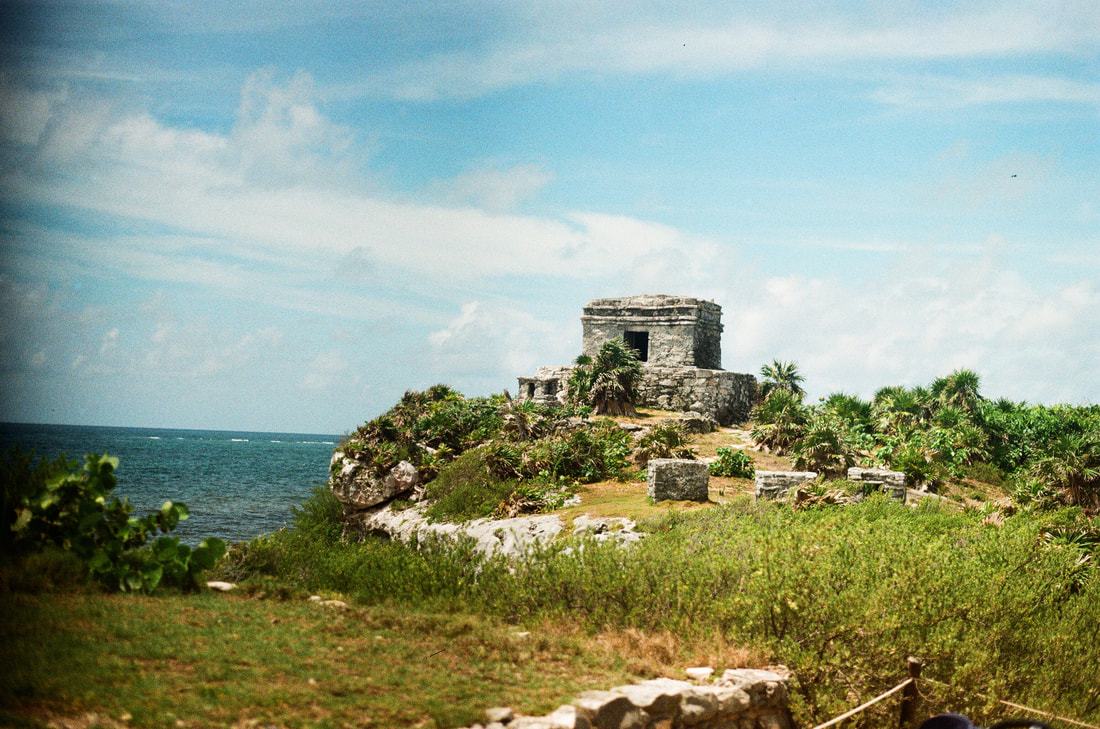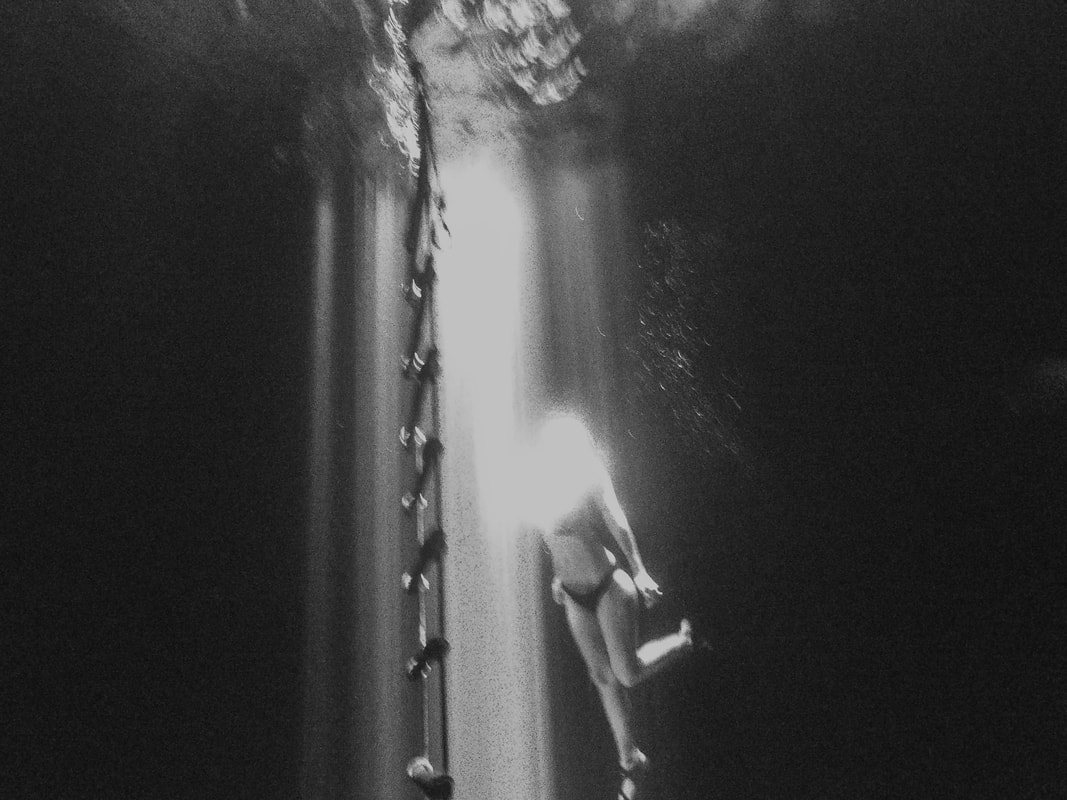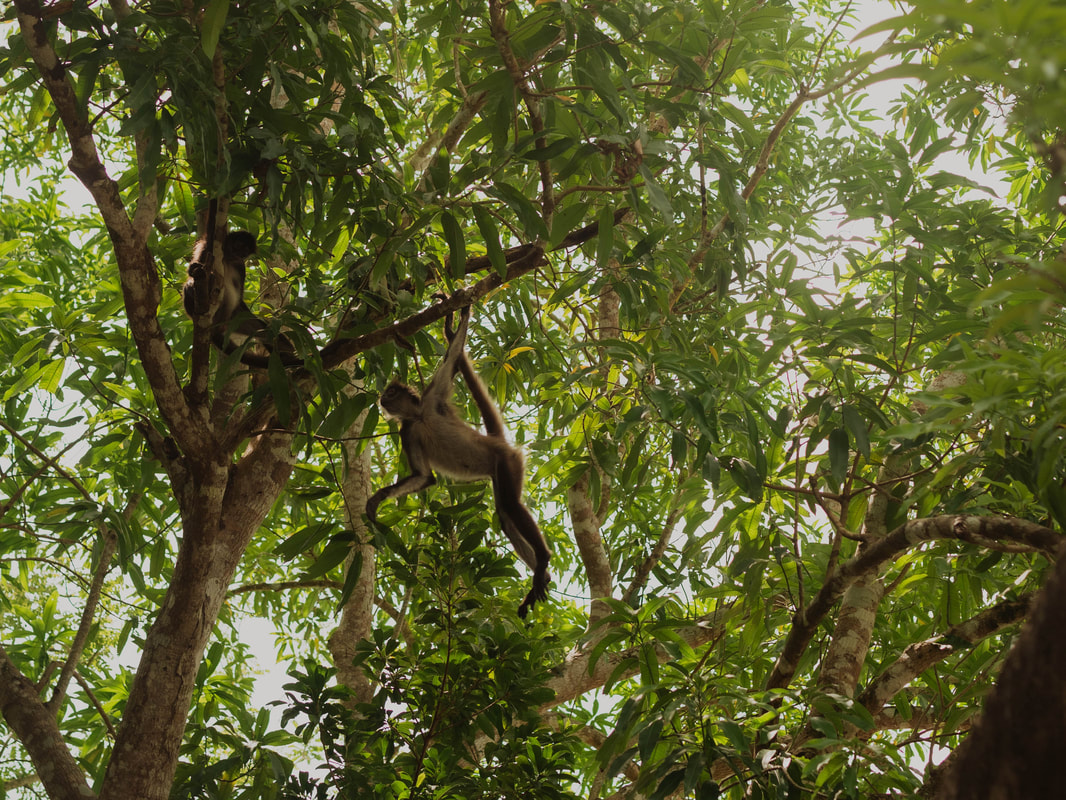Mexico Travel Guide: Tulum and the Yucatán Peninsula
June 2021
June 2021
|
Our visit to Tulum was an amazing experience. The Yucatán peninsula is a huge playground made up of incredible geography, vibrant scenery, fascinating culture and a ton of adventure. We’re stoked to share our experience with you and hope to help you with some facts and info that we learned about the area on our travels.
|
|
History of The Yucatán Peninsula
Millions of years ago, the planet was warmer, sea levels were higher and the submerged Yucatan peninsula was a vibrant coral reef. As the world cooled down, ocean water froze at the poles, dropping sea levels and exposing the underwater peninsula to the surface. The sea life fossilized into an expansive terrain of flat and brittle limestone that was soon covered with tropical foliage.
Then, 65 million years ago, the Chicxulub comet struck the northern end of the Yucatan peninsula and created the conditions that wiped out the dinosaurs. It also shook all that brittle limestone throughout the peninsula, cracking the ground and opening holes in the rock, creating a porous network of underwater river systems. There are no rivers in Yucatan, instead, fresh water runs underfoot, filtered through miles of rocks and roots. Openings in the limestone that lead to the water below are called Cenotes, and thousands of them dot the landscape. Slowly, humans settled in and eventually created the Civilization of the Maya.
Thousands of Ancient Mayan ruins are scattered throughout the peninsula today, hidden in dense trees and under layers of loamy soil. The expansive civilization was already crippled from inner conflict when the Europeans first arrived. When the two worlds collided, Old World diseases like smallpox and polio spread out in front of the Spanish soldiers to cripple the New World’s villages before any European even saw them. Once conquered, Spanish haciendas and chapels replaced wooden huts and stone temples. Those have given way to resorts and adventure centers that line the western coast of the Yucatán peninsula. Today, all of this has come together to be a place of knowledge, history, beauty and adventure for people from all over the world.
Millions of years ago, the planet was warmer, sea levels were higher and the submerged Yucatan peninsula was a vibrant coral reef. As the world cooled down, ocean water froze at the poles, dropping sea levels and exposing the underwater peninsula to the surface. The sea life fossilized into an expansive terrain of flat and brittle limestone that was soon covered with tropical foliage.
Then, 65 million years ago, the Chicxulub comet struck the northern end of the Yucatan peninsula and created the conditions that wiped out the dinosaurs. It also shook all that brittle limestone throughout the peninsula, cracking the ground and opening holes in the rock, creating a porous network of underwater river systems. There are no rivers in Yucatan, instead, fresh water runs underfoot, filtered through miles of rocks and roots. Openings in the limestone that lead to the water below are called Cenotes, and thousands of them dot the landscape. Slowly, humans settled in and eventually created the Civilization of the Maya.
Thousands of Ancient Mayan ruins are scattered throughout the peninsula today, hidden in dense trees and under layers of loamy soil. The expansive civilization was already crippled from inner conflict when the Europeans first arrived. When the two worlds collided, Old World diseases like smallpox and polio spread out in front of the Spanish soldiers to cripple the New World’s villages before any European even saw them. Once conquered, Spanish haciendas and chapels replaced wooden huts and stone temples. Those have given way to resorts and adventure centers that line the western coast of the Yucatán peninsula. Today, all of this has come together to be a place of knowledge, history, beauty and adventure for people from all over the world.
Tulum
|
We stayed in Aldea Zama, a quickly growing neighborhood on the south side of town about 3 miles from the ocean. Tulum is one of the fastest growing areas in the entire world. Only a few years ago it was a quiet fishing village, but now it hosts thousands of visitors every day. The beach zone is a modern trendy area with a narrow bumpy road that runs along the ocean lined with bohemian shops, bougie restaurants and unique architecture. Elegant boutique hotels line the beaches and provide high-end luxury experiences. Tulum is a product of social media tourism and people wait in line to have their pictures taken in front of the Tulum Lady. Rapid growth means that during busy times, Tulum can become congested as infrastructure has struggled to keep up. It’s an interesting paradox to see beautiful modern buildings lining such a busy worn down road.
|
|
We were there in the off season, so we didn’t have to deal with crowds. Unfortunately, April through August is “sargazo” season along the Mayan coast and on our trip we saw plenty of it. Sargassum is a seaweed that blooms off the coast, then gets deposited onto the sandy beaches in massive mounds of plant material. Crews with tractors, shovels and wheelbarrows work tirelessly to clear the beaches all day only to watch it all wash back up with each wave. At this time of year, the vibrant turquoise water is a softer green and the white sand along the shore is covered under a layer of brown seaweed. When this happens, your best bet for beaches are the ones cleaned by resort staff, the beaches on the east side of the offshore islands of Cozumel and Isla Mujeres, or beaches on the north end of the peninsula away from the currents.
|
Luckily, there’s no shortage of exciting things to do along the Mayan Riviera so instead of tanning our bodies on a relaxing beach, we headed inland for new experiences.
Ruins
|
Tulum Archaeological Site
The Tulum Archaeological Site hangs onto the edge of the western side of the Yucatan peninsula in Quintana Roo. It’s a fascinating preservation of a community that lived in well-built stone structures in a tropical environment. It was our first stop during our stay in Tulum and it was an incredibly somber experience to imagine the people who used to live here. |
|
Cobá
The Cobá ruins are the leftovers of an incredible city that stretched over 81 square kilometers and had 50,000 residents at its peak. It’s a beautiful flat walk through the jungle stopping at ruins along the way. You can even rent a bicycle if you’d rather not have to walk around the large archaeological site. |
About the Ancient Maya
Mayan culture mixed politics with religion, giving full power to the local King, who acted not only as ruler but as prophet, dictating the will of the gods to the people. Kings would often seek other states of consciousness through preparation of herbal drinks and bloodletting ceremonies, drawing their own blood until reaching a trance and speaking words that were written down and turned into policy.
The mystical portal-like openings of cenotes make it easy to see why the Mayans believed cenotes to be doorways into Xibalba, the underworld. Xibalba was a place parallel to our own world, but upside down and underwater. Spirits and demons would use cenotes as waystations between the natural world and Xibalba. Tributes and offerings were cast into Cenotes in hopes of finding favor with the many Mayan gods.
The mystical portal-like openings of cenotes make it easy to see why the Mayans believed cenotes to be doorways into Xibalba, the underworld. Xibalba was a place parallel to our own world, but upside down and underwater. Spirits and demons would use cenotes as waystations between the natural world and Xibalba. Tributes and offerings were cast into Cenotes in hopes of finding favor with the many Mayan gods.
Cenotes
|
Cenote Chan Chemuyil
Cenote Chan Chemuyil is a small Cenote on the edge of a new housing development. We parked only a few feet away and walked to a couple of swimming holes full of clear blue water. It helped to have snorkeling gear because the cenotes are even deeper than you’d expect at the surface. Even these little cenotes ones had caves and tunnels that ended in darkness so exploring them does feel like going into another world. |
|
Choon-Ha and Takanch-Ha
These two cenotes are only a few hundred yards away from each other, but they’re both different experiences. Steep slick stairways take you into large underground caverns through broken holes in the ceiling. Choon-ha is open like an amphitheater surrounded by stalactites and stalagmites. Stairs lead you gently into the water. Takanch-Ha has platforms for jumping off into the deep water below. Both cenotes were a surreal experience as you walk from a bright green jungle into a dark open cavern and then dive under the surface into the water network that spreads like veins through the land. |
Activities
|
Punta Laguna Monkey Sanctuary
Punta Laguna Monkey Sanctuary is about an hour north of Tulum, and it was a lot of adventure in one experience. Tons of fun! We started our tour off with a traditional Mayan blessing from the local Shaman in the ancient language. He asked the gods for permission to let us swim in their Cenote. As the guide took us on a gentle hike through the jungle, we watched the spider monkeys swinging above and he explained that the guttural moan from the howler monkey is them complaining about the headaches brought on by the heat. We ziplined across the lake, kayaked back and were lowered through a narrow hole in the ground into the cavernous cenote below. Our guides were extremely informative and accommodating, but we still weren’t sure if their jokes about human skulls at the bottom of the dark cenote were actually jokes. |
|
Aldea Maya Xunáan Kab
This small village was a fantastic stop along the way back from the two Cenotes. It’s a small village of two families who are preserving the Mayan lifestyle. They were kind people who took the time to show us their lifestyle, make us classic Mayan lunch and help us make tortillas. We loved the small stingless honey bees that they casually keep in log hives next to an ancient ruin on their land. There was no direct charge for entry but we left a generous tip and purchased some souvenirs from their shop. |
Beaches
We know, you didn’t think we’d include a beaches section after what we wrote about the sargazo, but we made the best of it and still found some great spots along the water.
We know, you didn’t think we’d include a beaches section after what we wrote about the sargazo, but we made the best of it and still found some great spots along the water.
|
Playa Esmeralda
In Playa del Carmen, we had a mix-up with the ferry times and had to rethink our plans. In these conditions, we found Playa Esmeralda and the small restaurant on the beach that we can’t remember the name of. Crews had been cleaning the beach of sargazo and scattered rain bursts kept the sand pretty empty, so eating ceviche under a palapa as the sun came out and lit up the water was just the experience we were hoping to have at least once while we were there. |
The Secluded Island of Holbox
We’d heard of a place on the north side of Yucatan with clean beaches and sunny skies called Holbox, and since our last full day together in Tulum was rainy we figured we’d make the trek to find it. We drove 2 ½ hours to Chiquila. It rained the whole way there and kept pouring as we tried to pay for a ferry ticket at offices that couldn’t accept cards because of weather related power outages. Eventually, we got our tickets and took the half hour ferry ride from Chiquila to the town of Holbox. There are no cars on Holbox, only golf carts and motorcycles, so we walked the width of the small town built on a sandbar made up of small modern restaurants, shops and lines of beach palapas. We chose to walk east along the length of the beach to Punta Cocos, where we found some unused palapas and beach chairs and set up camp for the afternoon. The sun came out and it was a beautiful day. The only time on our trip we were able to really enjoy the caribbean ocean without sargazo, which made it an extra special experience.
We’d heard of a place on the north side of Yucatan with clean beaches and sunny skies called Holbox, and since our last full day together in Tulum was rainy we figured we’d make the trek to find it. We drove 2 ½ hours to Chiquila. It rained the whole way there and kept pouring as we tried to pay for a ferry ticket at offices that couldn’t accept cards because of weather related power outages. Eventually, we got our tickets and took the half hour ferry ride from Chiquila to the town of Holbox. There are no cars on Holbox, only golf carts and motorcycles, so we walked the width of the small town built on a sandbar made up of small modern restaurants, shops and lines of beach palapas. We chose to walk east along the length of the beach to Punta Cocos, where we found some unused palapas and beach chairs and set up camp for the afternoon. The sun came out and it was a beautiful day. The only time on our trip we were able to really enjoy the caribbean ocean without sargazo, which made it an extra special experience.
Restaurants
It's an endless task to list all of the great places to eat in Tulum, but here are a list of our favorites,
- BURRITO AMOUR
- HABITAS
- HOLISTIKA
- EL PEZ
- ITALDO COFFEE SHOP
- SAFARI
- COCONUT + MANGO STREET VENDORS
- EL CAMELLO JR
- ANTOJITOS LA CHIAPANEC
We had a fantastic experience in our time in Tulum, and even though the sargazo was a bit of a bummer, there was so much to see and do that we still had fun every day! We wanted to leave you with a few tips for traveling through the area. A few things we’ve learned along the way.
Quick Tips
- Everything is negotiable. Don't pay the first price shop owners throw out there when you're buying from street vendors.
- Be careful with the taxi drivers. Especially at the airport. The shuttle company told us that sometimes if you’re on the phone with the shuttle, the taxi drivers will offer help by saying they can talk to the hotel for you, but they'll lie and say the shuttle isn't working so they can get you to pay for a taxi ride.
- When you land in Mexico be sure to keep the paperwork they give you because you'll need it to board the plane when you leave the country. If you lose it you'll have to pay a fine around $100 USD.
- During bad weather days, sometimes places will lose internet connection and won’t accept cards. When it’s gloomy out, be prepared with some extra pesos just in case.
Thanks for reading,
Ben and Courtney Nielsen
Sand and Stone Media
Ben and Courtney Nielsen
Sand and Stone Media









